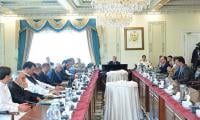Imports to increase $4 billion
ISLAMABAD: The International Monetary Fund (IMF) foresees the current account deficit widening to $5.436 billion in the current fiscal year of 2016/17 from $2.885 billion in the previous fiscal year mainly because of rising imports and sluggish exports.
The IMF, in its report released after the completion of the 11th review of its $6.7 billion extended fund facility (EFF) program, says in percent of GDP the current account deficit (CAD) will ratchet up to 1.8 percent by the June-end next year as compared to one percent this year.
The Fund further says the CAD will go up to 2.3 percent of GDP, or $7.4 billion, in 2017/18 and $8.045 billion in 2018/19.
It says the country will receive $900 million from the U.S. on account of coalition support fund (CSF) during the current fiscal year as against $937 million received during the last fiscal year. There will be no CSF receipts for the next three fiscal years (2017/18 to 2019/20), it adds.
The staff report forecasts the foreign reserves of the State Bank of Pakistan at $20.279 billion as at June 30, 2017.
It says exports could fetch $22.8 billion in the current fiscal year as compared to $21.9 billion a year ago, while imports might rise to $43.5 billion from $39.5 billion.
The IMF report did not specify the reasons behind the widening current account gap.
Economists said the imports are bound to increase in months and years to come due to the ongoing China Pakistan Economic Corridor projects.
The workers’ remittances are projected at $19.6 billion in 2016/17 as compared to $19.1 billion in 2015/16.
The Fund says the country’s external debts will shoot to $59.6 billion in the current fiscal year from $56 billion as of June 2016.
The debt sustainability analysis shows that external debt will remain on a downward trend over the medium term under the ‘most stress scenario’, with the peak in external financing needs under the ‘most severe stress scenario’ (3.7 percent of GDP) staying well below the risk assessment benchmark of five percent of GDP.
“Pakistan’s financing needs are fully covered for the remainder of the program and the country’s capacity to repay the Fund remains strong owing to supportive macroeconomic policies, resilient remittances inflows, and increasing foreign exchange reserves,” the IMF says.
“Pakistan benefits from disbursements from multilateral and bilateral partners, which are expected to continue beyond the ongoing program, and has access to international markets, which limits short- and medium-term financing risks.”
The Fund has so far released $6.01 billion under the EFF program. In September 2013, the IMF had approved the 36-month loan.
The government requested the IMF a short extension of the EFF arrangement from September 3 through September 30 to allow sufficient time to conduct discussions for the final review.
The IMF projects the gross financing requirement at $11.432 billion during the current fiscal year as against $7.297 billion a year ago.
While short term financing risks are limited, the materialisation of risks to the economic outlook could erode Pakistan’s capacity to repay to the Fund.
The headquarters of the Sui Southern Gas Company . — APP FileKARACHI: Sui Southern Gas Company has launched a fresh...
The logo of the ExpoMed Eurasia. — CA MI websiteKARACHI: Pakistan is participating in ExpoMed Eurasia, a leading...
Gold bars are seen in this undated file photo. — AFP/FileKARACHI: Gold prices increased by Rs500 per tola on...
FFBL Head Office building can be seen in Islamabad. — FFBL WebsiteKARACHI: Fauji Fertilizer Bin Qasim Limited has...
Representational file of an BMW car. — AFP FileLAHORE: Small improvements in economic credentials of the country are...
A fuel station worker filling petrol in vehicle at a fuel station in Karachi on Tuesday, April 16, 2024KARACHI: After...







